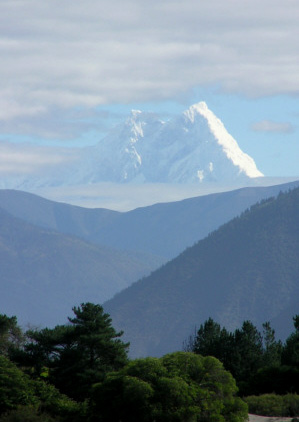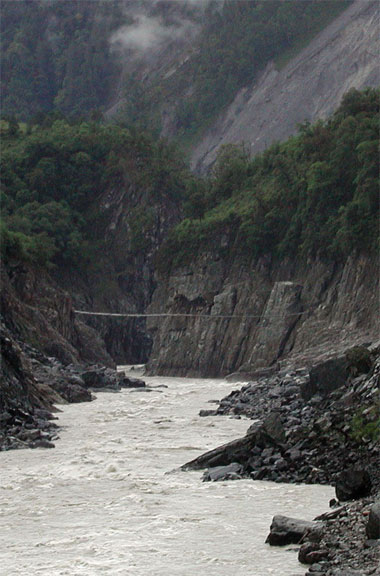Project Summary, Geodynamics of Indentor Corners
The National Science Foundation requires proposals to have a project summary that is generally intelligible
and not aimed at specialists. We tried!

Gyala Peri seen from the southwest
Proposal Summary
Across the northeastern margin of the Indian plate in southeastern Tibet, the Himalayan orogen terminates abruptly as collisional processes responsible for the elevation of Tibet and the tectonics of the main Himalayan range are replaced by the strike-slip tectonics of the eastern Himalayan syntaxis. The syntaxis occupies a sizeable portion of the diffuse India-Asia collision zone, and because it serves as the watershed for the largest rivers in Asia, its highly active tectonic and surface processes have a direct impact on over one billion people.
Modeling suggests that the syntaxis is a crustal manifestation of the complex lithospheric dynamics associated with an "indentor corner." Steep lateral velocity gradients mark the eastern margin of the Indian plate, and incoming Indian lithosphere is partitioned into at least two components: deeper Indian lithosphere that continues north beneath Tibet, and shallower lithosphere that decelerates and, together with overthrust Asian lithosphere, enters the clockwise deformation regime of the eastern syntaxis. Such corners are also sites of significant accommodation of crustal convergence by erosion and fluvial evacuation, and transfer of material between all these elements at high rates and short time scales.

Looking south down the Po-Tsangpo from Parlung
We propose to use the eastern syntaxis of the Himalyan orogen to address key questions in the geodynamics of continental collisions: how do orogens and associated plateaus come to an end, how do tectonic and surficial processes interact to shape the crust during orogeny, and how is deformation partitioned at various scales? These issues, enigmatic in older orogens, are resolvable in young and active region such as the India-Asia collision. Our work will involve testing three linked hypotheses: (1) across the transition from Tibetan plateau to eastern indentor corner, changes in lithospheric rheology are an important control on changes in topography and lithospheric mechanics; (2) erosion plays an equally important role in controlling lithospheric dynamics, on par with crustal thickening and lateral accommodation, and feedbacks between the two ultimately shape the evolution of the orogen, and (3) within the syntaxial region, there is nearly complete decoupling between deformation in the upper crust and the deeper lithosphere. To test these hypotheses, we will track the magnitude, rates, and type of mass fluxes through the central region of the eastern Himalayan syntaxis. To do this we will use isotopic, geochronologic, geomorphologic, GPS, petrologic, seismologic, and structural techniques, fully integrated by three-dimensional modeling. The young structures and active processes in the region will permit us to meaningfully combine short-timescale measurements (e.g. seismological, GPS, geomorphic observations) with measurements made over a longer range of temporal scales (e.g. petrological, structural, geochronological observations) on material that is moving through the region and hence records a complex time-integrated pressure, temperature, and strain history.
This work will complement and integrate other NSF-supported studies of the diffuse India-Asia collision by examining mass transfer across one of the systemÕs fundamental yet poorly understood boundaries. Together with these other studies, our proposed project will help provide a coherent image of lithospheric structure and rheological variations for an orogen that remains the textbook example of collisional mountain building.